2017 Richard Hoppe-Sailer
The notion of a conceptual art for the senses
Richard Hoppe-Sailer // The notion of a conceptual art for the senses
Characterizing these objects that Sabine Straßburger creates is no easy task. They mock us initially with their wry insolence, their purpose as seemingly self-evident as it is obscure, not least because of the richness of their allusions, which open up a wealth of various associations. Categorially they consist of artefacts functioning at and beyond the margins of possible but often hitherto unrecognizable genre classifications. There is, at the same time, a virtual, operative aspect to these works, which prompts the viewer to make corrections and fill in possibly missing elements. This performative impulse, once we become aware of it, is vexing, not only because of its virtual nature, but because of the obvious impossibility as we become aware of the difficulties such an intervention would entail. Such an ex negativo characterization of Straßburger’s work, however, does not spare us in our endeavour to characterize it. This only becomes possible – and is what makes these works particularly unique – once we begin to engage in a separate description and analysis of the singular works. Only then does the function of each piece in all its exasperation and many allusions become clear.
If we take, for example, the group with the title Motivsucher [viewfinder] and further note that one of the works is dedicated to the director Peter Greenaway, we begin to discern the extent to which media reflexivity plays a role in Straßburger’s work.
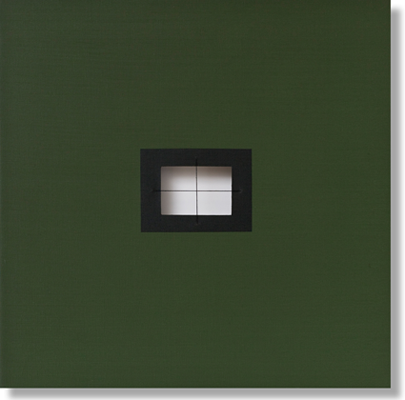
Motivsucher [für Peter Greenaway] 2010, 50x50cm Öl, Faden/Leinwand
These seemingly unremarkable objects reveal themselves to be complex structures that variously address the age-old tradition of perspective painting, i.e., the depiction of the three-dimensional world within the two dimensions of the flat canvas. In Dürer’s perspective studies from the early 16th century, one finds a series of graphic works depicting the artist’s studio that reveal precisely this process. Dürer illustrates the use of various devices to achieve a mathematically precise, almost mechanically exact reproduction. This same image association arises with Straßburger’s Viewfinders, much as it does in Greenway’s 1982 film “The Draughtsman’s Contract”, in which an English provincial aristocrat of the late 17th century engages an artist to visually document his holdings. Against the background of Michael Nyman’s minimalistic music, we bear witness to a maniacally precise documentation, in which the viewfinder becomes a reoccurring motif emblematic of the artist’s efforts. Examining the various iterations of Viewfinder, the full extent of Straßburger’s involvement with this imaging instrument becomes clear. In addition to the allusion to the grid structure, she furnishes it with a frame of ruled paper, further emphasizing the precision, and realizes it finally as a three-dimensional object through which one can actually look.
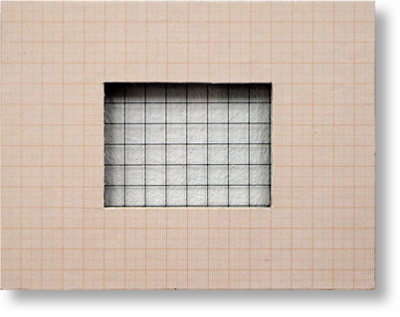
Motivsucher >genau werden< 2012 4x18cm, Auflage: 4 EX. Millimeterpapier, Karton, Kunststoff
The view is of the interior of the box or else the surface of the wall behind; thus the duality of flat surface and three-dimensional space – for whose pictorial treatment it was developed – is inscribed in the work itself, reinforcing its highly self-referential nature.
In a further group of even more object-like artworks, we are confronted with questions about the physicality of the canvas itself – the image medium – and its framing structures. Two picture elements, placed apart on the wall and denoting the upper and lower borders of an imaginary painting, underscore the relevance of the border between canvas and wall for the pictoriality [Bildhaftigkeit] of the object itself.
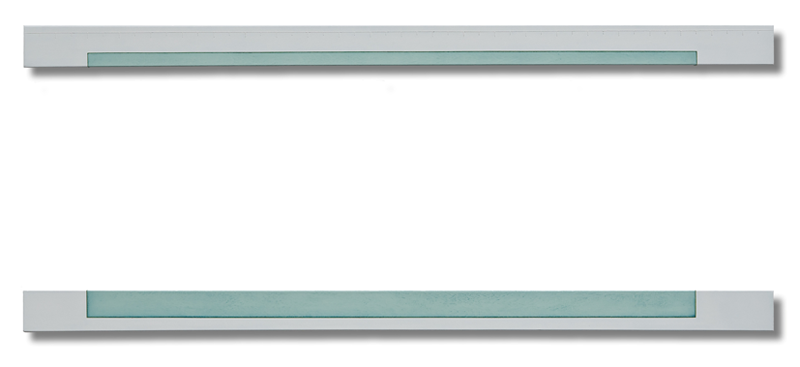
teils [frz. Marine Nr.120] 2009, 109x240cm, 2-teilig Öl/Leinwand
But just what sort of a work is this? To the extent that it incorporates the apparent elements of such, it harks back to the tradition of panel painting. The relationship between deconstructed panel and surrounding wall surface introduces a certain visual suspense that on the open, unbounded sides diffuses out into the breadth of the surrounding wall surface; the result is essentially a multi-piece wall installation.
In the aforementioned examples, the various framing elements have been pulled apart, but in other works by Straßburger they are closed up, shoved tightly together, and take on the nature of a relief. In some of the works we see hybrid forms develop that serve to link pictorial deformation and wall surface. Each of these works carries with it, as noted, an obvious performative aspect. We are confronted with repeated references to the essential structural elements that comprise a painting, but the very act of viewing prompts us to experience each work as a construct, whose deconstruction demonstrates the essence of its constructedness.
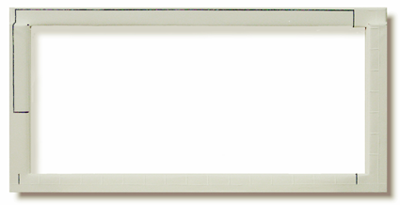
lost portrait – shaped canvas 2013, 44,5x90cm (aus 120x90cm) Öl/Leinwand a. Keilrahmen, gefaltet
Sabine Straßburger pursues variations on this same theme in a number of forms; time and again we are asked to subtly engage with the nature of the painted canvas itself, be it the problematic relationship of the three-dimensional world to the two-dimensional projection plane, the interrelationship of canvas, exhibition wall and space, modes of demarcation by means of internal compositional framing vs. external frame, or pictorial relief work alluding to the compositional methods of the Russian constructivists. One surely fascinating aspect of the artist’s work is the ironic stance it takes to the aforementioned processes of deconstruction. It is a highly self-reflective form of irony, which, in the best romantic tradition reveals within the work itself its own constructedness.
With her incorporation of such self-referential aspects, the artist at the same time alludes to the history of the medium itself. This form of meta-painting, to use a term from Viktor Stoichitas, is preoccupied not only with the particular modalities of a painting, but also with the historical authenticity of such modalities. The Viewfinders allusion to Greenaway also evokes more distant references to Dürer and the development of perspective painting; reflections on the use of frames and framing devices elicit references to the work of Robert Ryman and 17th-century trompe-l’œil techniques; issues of “objectness” call to mind references to minimal art.
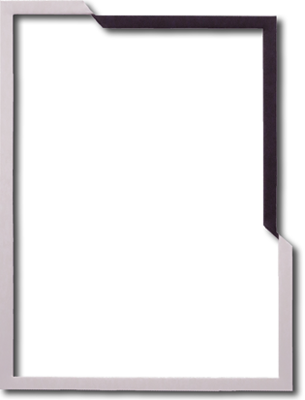
Hommage an Sigmar Polke [höhere Wesen befahlen: obere rechte Ecke (umknicken) schwarz malen] 2015, 120x90cm Öl/Leinwand
Behind this is neither an attempt at naïve recitation nor simply a postmodern concept, but rather an effort to further advance those artistic explorations, in particular, that have played an important role in classic modernism and post-war modern art. Sabine Straßburger carries out these visual inquiries by means of intuitively accessible visual experiments that uniquely contrast materiality and material perception.
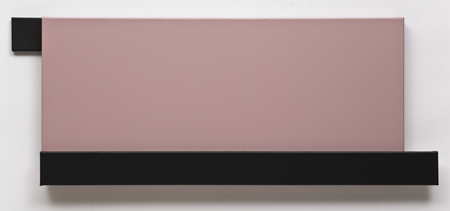
Versuchsanordnung >hinter-vor< 1 2014, 50x130x7,5cm 3-teilig Öl/Leinwand
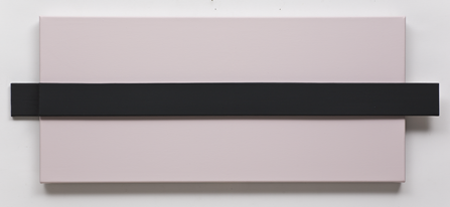
Versuchsanordnung >hinter-vor< 2 2014, 50x130x7,5cm 3-teilig Öl/Leinwand
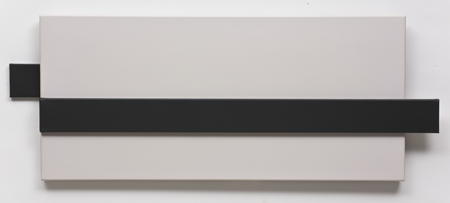
Versuchsanordnung >hinter-vor< 3 2014, 50x130x7,5cm 3-teilig Öl/Leinwand
Through their uniquely self-referential relationship to the exhibition space and active engagement of the viewer’s receptivity, Straßburger’s art directly links the physicality of the artwork and its perception by the viewer – the result: conceptual art as a sensuous experience, which by means of numerous approaches explores questions about the nature of the painting itself, and in response offers an aesthetic visual model that illustrates the fundamental unanswerability of such questions – a further aspect of pictoriality.
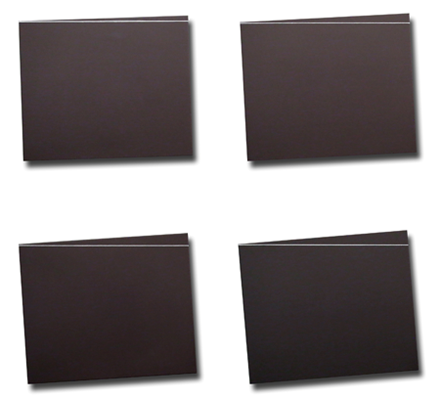
Serie „schief“ 2° | 3° | 4° | 5° 2016, 50x60cm, je Öl/Leinwand
In Sabine Straßburger’s work we discern the fundamental structure of the painting in such a way that we not only become aware of its materiality, historicity, and constructedness, but also its medial particularity – its fundamental untranslatability. The greater our temptation to yield to their ironic presence, the further these works withdraw from us.
Translated by Kevin Pfeiffer